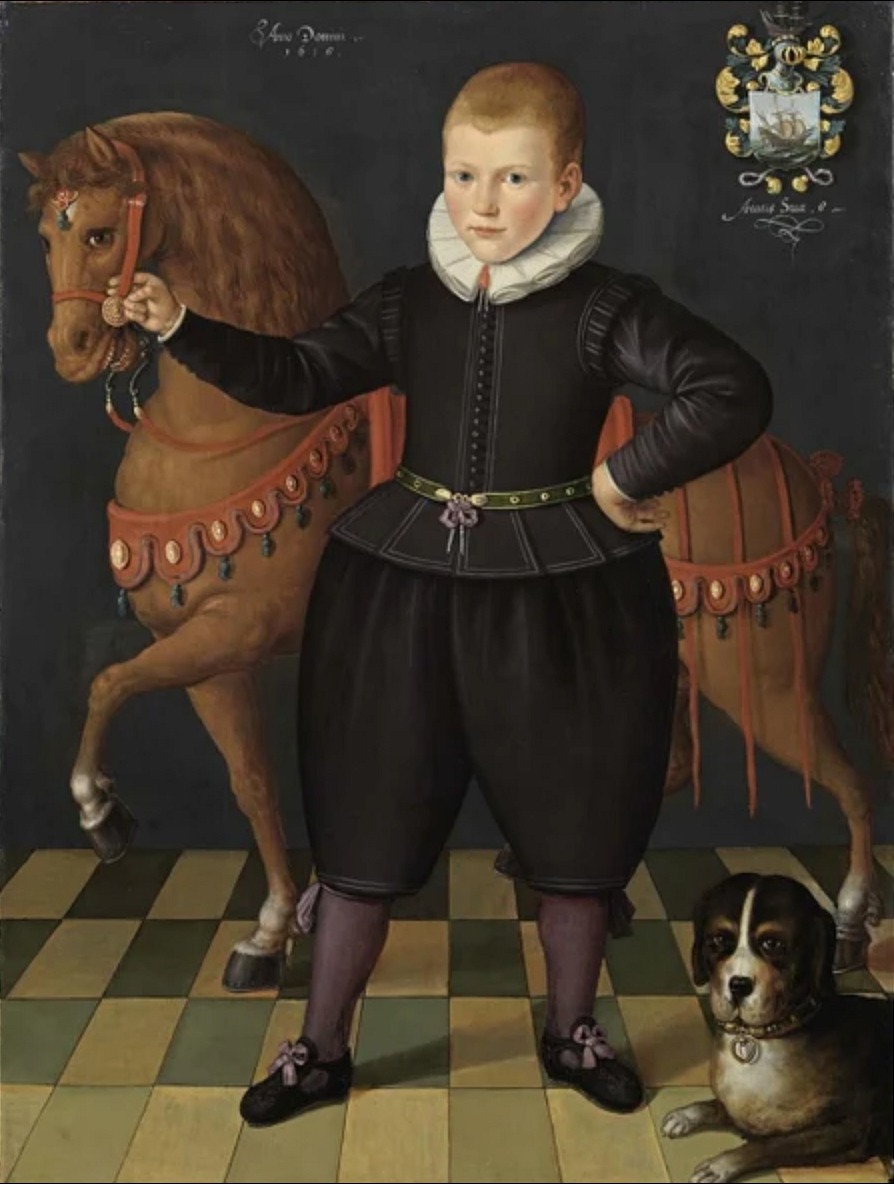Attributed to Jan Claesz.
Portrait of a young boy with a small horse
Oil on panel : 118 X 82,5 cm
Unsigned, dated “1618”
Sold at Sotheby’s Paris, 24/06/09
For 360.750 €
This is a comparative item

Painting for Sale

Doncker, Attributed to Herman
"A family portrait with a small pony"
In short
Herman Docker was born in Hoorn, in West-Friesland. Around the age of fourty he was active in Haarlem, in Holland, painting genre scenes. Some five years later he moved to Enkhuizen, which was also a West-Frisian port, like nearby Hoorn.
In Enkhuizen Doncker specialised in portraits, such as our painting. The stiffness of his figures and the rather old-fashioned, but expensive black clothing are typical of West-Frisian portraiture. Doncker painted it during the 1640s. He must have died here around 1650/51.
Early 17th century Dutch boy’s portraits with ponies are extremely rare and very sought-after. In 1609 Jan Claesz., who had also been active in Enkhuizen, painted a portrait of a five-year old boy with his pony ; it is being exhibited at the Enkhuizen Town Hall. Another boy’s portrait with a small horse, dating from 1618 and attributed to Jan Claesz. was sold at Sotheby’s Paris for 360.750 €.
About Herman Doncker
Dutch painter
Hoorn, 1595 – circa 1650/51, probably in Enkhuizen
His name is sometimes spelt Herman Mijnerts or Herman Meindertsz. Doncker.
Doncker is documented as a painter in two towns:
- in Haarlem (an important economic centre some 15 km W. of Amsterdam);
- in Enkhuizen (a port town on the ‘Zuiderzee’ some 40 km N.E. of Amsterdam).
He married in 1619 in his native Hoorn, 20 km SW of Enkhuizen.
It is not known whom he studied painting with.
Herman Doncker joined the Guild of Painters in the city of Haarlem in 1634. His earliest dated works are from that very year; at that period he was already almost 40 years old. In 1635 he is still documented in Haarlem. All of Doncker’s dated genre scenes are from the period 1634/1636. By 1636 he might already have lived in Hoorn or maybe in Edam, where he had an important commission. In the period between 1641 and 1646 he lived in the town of Enkhuizen. He must have arrived before 1640 and remained here well after 1646. Here, in West-Friesland he specialised into portrait painting. In 1644 and 1645 he occasionally turned to history painting: five examples from these two years are known. His last dated work is from 1650.
Doncker regularly signed his paintings, either in full, or with his ‘HD’ monogram. Our painting is sadly unsigned.
There is a clear stylistic difference and evolution in the paintings of Doncker:
- his early paintings, made during his stay in Haarlem, and possibly in Hoorn or Edam, around the middle of the 1630-ies can be considered modern for their days. Although not a large town Haarlem was one of the most important cultural centres of Holland during the Golden Age of the 17th century; it housed an incredible number of very important painters such as Frans Hals, Hendrick Goltzius, Hercules Seghers, Esaias van de Velde, Jan van Goyen, Jan Miense Molenaer, Judith Leister, Adriaen Brouwer, the van Ostade brothers, the Ruisdael-Ruysdael family, Pieter Claesz., Willem Heda and many more.
- the second and largest group of paintings date from the 1640-ies, when Doncker lived in Enkhuizen, a smaller town whose population favoured an old-fashioned stiffness of portrait paintings typical of this Northern part of Holland. Our painting dates from this period. Enkhuizen was in the first half of the 17th century an important, small, rich harbour town, with many potential clients for portrait painters. Best known are, besides our painter, Christiaan Jansz. Coevershoff (1595 – 1659), Gerbrand Ban (1613 – 1652) the earlier painter Jan Claesz. (1565 – 1618) and the younger painter Jan van Neck (1634/35 – 1714).
Enkhuizen and Hoorn lay on the Zuiderzee, in West Friesland, North of Amsterdam and of the province of Holland. Enkhuizen was a small, but rich town with a very important fishing port. During the 17th century Enkhuizen had the largest hearing fleet from the Dutch Republic. It shared with neighbouring Hoorn one of the smaller admiralties of the navy of the Dutch Republic, the Admiralty of West Friesland or of the Northern Quarter (‘Noorderkwartier’), which was created in 1589. Every three months, from 1597 on, it switched its location between Enkhuizen and Hoorn. The other admiralties were Amsterdam, Zeeland, Rotterdam and Friesland.
Enkhuizen, Hoorn, Delft and Rotterdam were also the smaller chambers of the Dutch East Indies Company, next to the much more important chambers of Amsterdam and of Zeeland. The Dutch East Indies Company was created in 1602. It had the monopoly on colonial activities in Asia.
Cape Horn, the most southerly point of the Americas, was named after the town of Hoorn by Willem Schouten, who rounded it in 1616.
Why should you buy this painting?
Because 17th century portraits with a pony or a small horse are extremely rare and very sought after.
Comparative paintings
Click photos for more details










